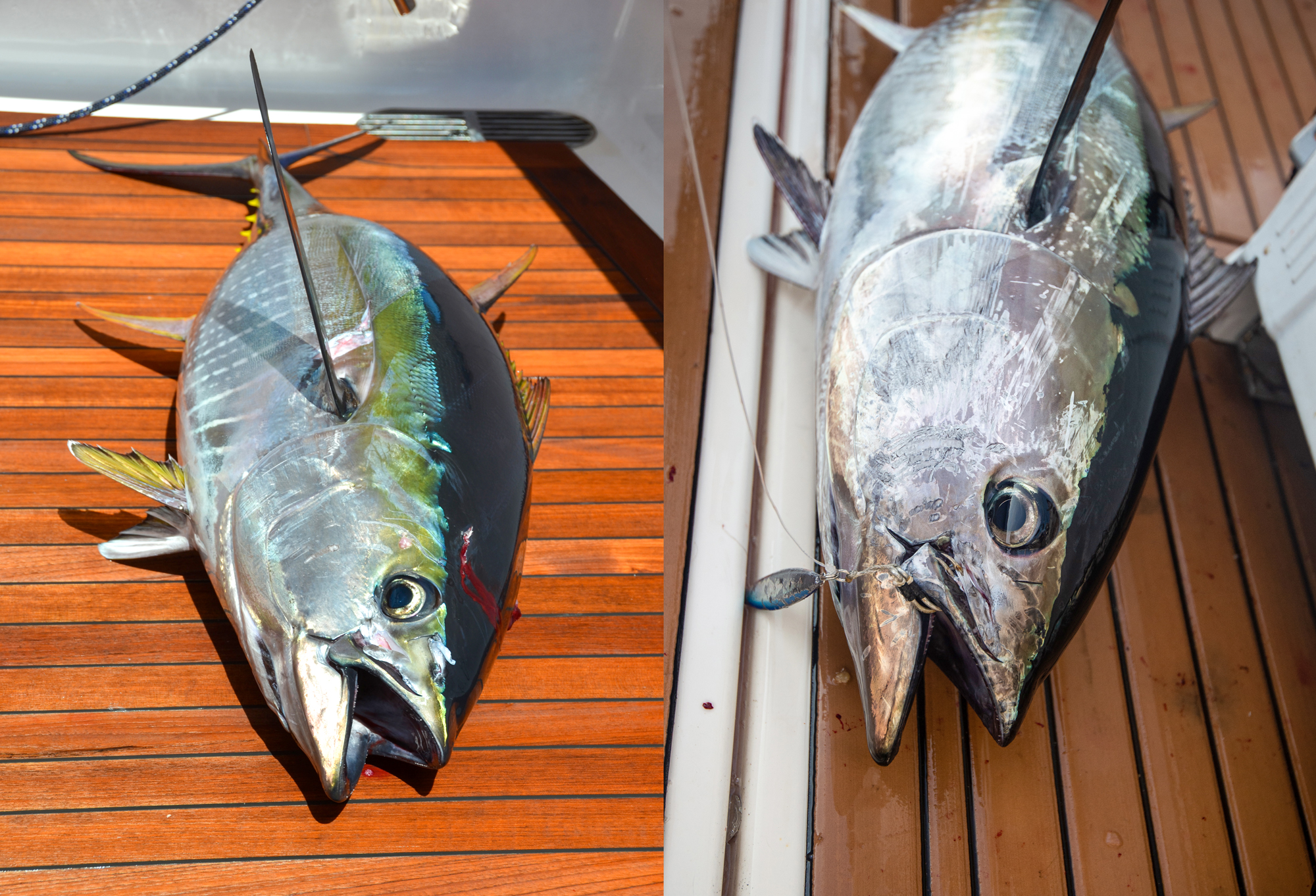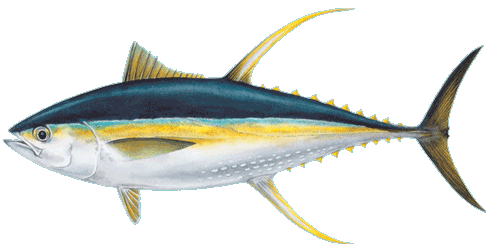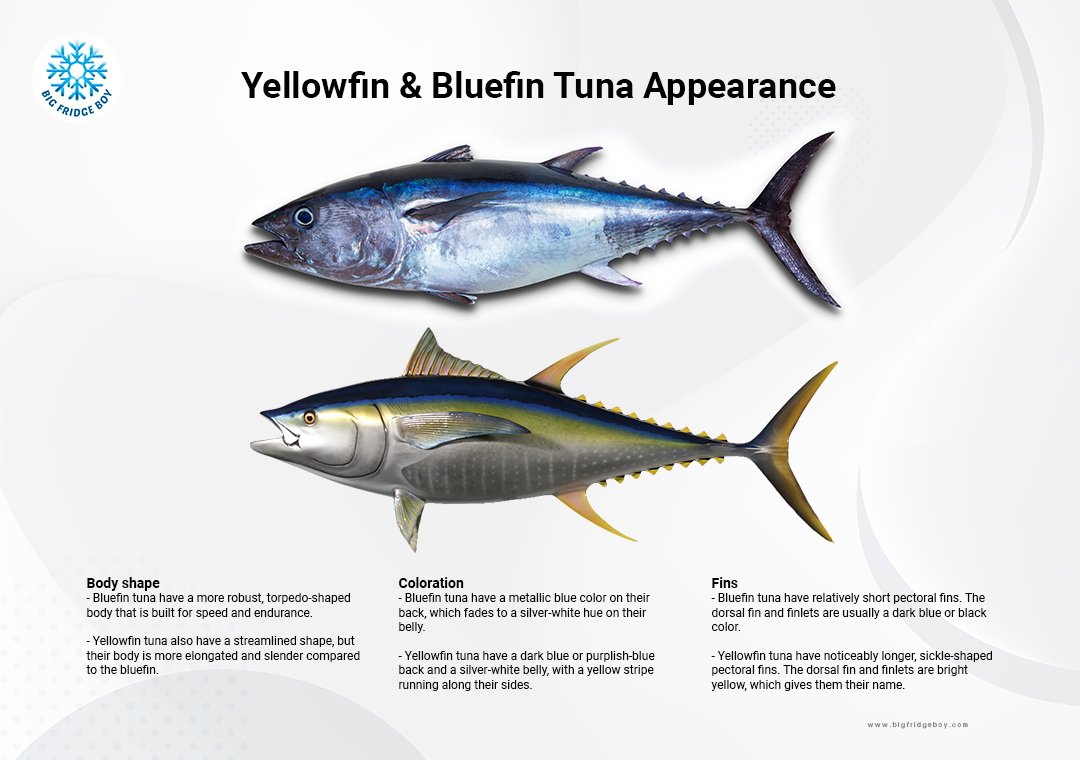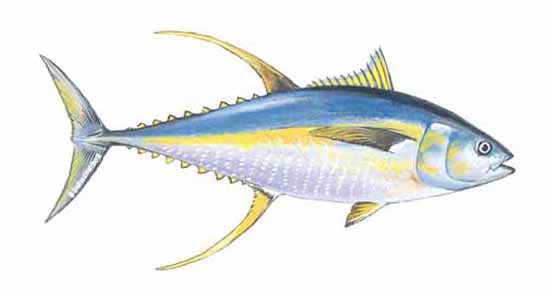Introduction

Yellowfin vs Yellowtail Tuna: A Tale of Two Tunas
The culinary world has been captivated by the flavors and versatility of yellowfin and yellowtail tuna. These two tuna species may share a similar name, but they have distinct characteristics and flavors that set them apart. In this article, we will dive into the differences between yellowfin and yellowtail tuna, exploring their taste, texture, cooking methods, nutritional value, and sustainability. Whether you’re a seafood enthusiast or a chef looking to add depth to your recipes, understanding the nuances of these tunas will help you make informed choices and create delectable dishes. So let’s embark on this flavorful journey and uncover the tale of two tunas.
The Popularity Of Yellowfin And Yellowtail Tuna In The Culinary World
Yellowfin and Yellowtail Tuna have gained immense popularity in the culinary world due to their exceptional flavor and versatility. Chefs and seafood enthusiasts alike value these tunas for their rich taste and succulent texture. Their distinct flavors add depth to various dishes, from sashimi and sushi to seared steaks and grilled fillets. As a result, yellowfin and yellowtail tuna have become sought-after ingredients in high-end restaurants and home kitchens, allowing individuals to explore and create delectable recipes that showcase the unique characteristics of these two tunas. Their popularity stems from their ability to elevate the dining experience and deliver exquisite flavors.
Yellowfin Tuna
Yellowfin Tuna, scientifically known as Thunnus albacares, is a highly prized species in the culinary world. It is characterized by its sleek, torpedo-shaped body and distinct yellow fins, from which it derives its name. Yellowfin tuna has a mild, slightly sweet flavor with a firm and meaty texture. Its flesh ranges from pink to deep red, making it visually appealing when used in various dishes. The versatility of yellowfin tuna makes it suitable for a range of cooking methods, including grilling, searing, and even raw preparations such as sushi and sashimi.
Yellowfin Tuna: Characteristics And Flavor Profile

Yellowfin Tuna, known scientifically as Thunnus albacares, is a highly sought-after species in the culinary world. Its sleek, torpedo-shaped body and distinct yellow fins make it visually appealing. Yellowfin tuna has a mild, slightly sweet flavor with a meaty and firm texture. Its flesh ranges from pink to deep red, enhancing the visual presentation of dishes. This versatility allows for various cooking methods, such as grilling and searing. It is also commonly used in raw preparations like sushi and sashimi. Yellowfin tuna’s unique characteristics and flavor profile make it a favorite choice for seafood enthusiasts.
Yellowfin Tuna: Best Cooking Methods
Yellowfin Tuna is known for its versatility in the kitchen, making it suitable for various cooking methods. The firm texture of yellowfin tuna makes it perfect for grilling, as it can hold up well to high heat without falling apart. Searing is another popular method that allows for a crispy exterior while maintaining a tender and moist interior. Yellowfin tuna can also be enjoyed raw in dishes like sushi and sashimi, highlighting its natural flavor and freshness. Whether grilled, seared, or served raw, yellowfin tuna is sure to delight seafood lovers with its delicious taste and texture.
Yellowtail Tuna
Yellowtail Tuna, also known as Seriola, is a highly prized fish species in the culinary world. It is characterized by its firm texture and rich, buttery flavor. Yellowtail Tuna is often compared to Yellowfin Tuna due to their similar appearance, but they have distinct differences in taste and texture. Yellowtail Tuna has a slightly milder flavor compared to Yellowfin Tuna, with a hint of sweetness. Its flesh is tender and succulent, making it suitable for a wide range of cooking methods. It can be grilled, baked, or even enjoyed raw in dishes like sushi and sashimi. Yellowtail Tuna is a favorite among seafood enthusiasts for its versatility and delectable flavor.
Yellowtail Tuna: Texture And Taste Comparison With Yellowfin

When comparing Yellowtail Tuna to Yellowfin Tuna, there are noticeable differences in both texture and taste. Yellowtail Tuna has a slightly milder flavor compared to Yellowfin Tuna, with a hint of sweetness. Its flesh is tender and succulent, making it a favorite among seafood enthusiasts. In terms of texture, Yellowtail Tuna is known for its softer and more delicate texture compared to the firmer and denser texture of Yellowfin Tuna. These differences make Yellowtail Tuna a great choice for those who prefer a lighter and more delicate eating experience. To indulge in the unique flavors and textures of both tunas, it’s best to try them for yourself and explore their distinct qualities.
Yellowtail Tuna: Culinary Versatility
Yellowtail Tuna is highly regarded for its culinary versatility. Its delicate texture and mild flavor make it suitable for a wide range of dishes. It can be enjoyed raw in sushi and sashimi, grilled for a smoky flavor, or baked and broiled for a more tender and juicy result. Yellowtail Tuna can also be marinated, pan-seared, or used in ceviche recipes. Its versatility allows chefs and home cooks to explore various cooking methods and flavor combinations to create delicious and unique dishes. Whether served as the main course or incorporated into salads and appetizers, Yellowtail Tuna offers endless possibilities for culinary creativity.
Nutritional Value
Both Yellowfin Tuna and Yellowtail Tuna are rich in essential nutrients. They are excellent sources of protein, providing roughly 29 grams per 100 grams of fish. Both varieties also contain omega-3 fatty acids, which are essential for heart health and brain function. Yellowfin Tuna is slightly higher in calories, with 100 grams containing about 184 calories, compared to the 187 calories in the same amount of Yellowtail Tuna. Both types of tuna are also low in saturated fat and cholesterol, making them a nutritious choice for a balanced diet.
Health Benefits Of Yellowfin Tuna

Yellowfin Tuna offers numerous health benefits due to its nutrient-rich profile. It is an excellent source of high-quality protein, which is essential for muscle growth and repair. Yellowfin Tuna also provides omega-3 fatty acids, which can help reduce inflammation in the body and promote heart health. Additionally, it is a good source of vitamins and minerals, including vitamin B12, selenium, and niacin, which support brain function, immune system health, and energy production. Incorporating Yellowfin Tuna into a balanced diet can contribute to overall well-being and provide a tasty way to meet nutritional needs .
Health Benefits Of Yellowtail Tuna
Yellowtail Tuna offers several health benefits due to its nutrient content. It is a good source of high-quality protein, which is essential for muscle development and repair. Yellowtail Tuna also contains omega-3 fatty acids, which support heart health and reduce inflammation in the body. Additionally, it is rich in B vitamins, including vitamin B12, which helps in brain function and energy production. The consumption of Yellowtail Tuna can contribute to overall well-being and provide a nutritious addition to a well-balanced diet .
Sustainability
Sustainability is an important consideration when it comes to choosing between Yellowfin and Yellowtail Tuna. Both species face challenges due to overfishing and the impact on marine ecosystems. Sustainable fishing practices, such as implementing catch limits and using selective fishing techniques, are crucial to ensure the long-term availability of these tunas. It is essential to support fisheries that adhere to sustainable practices and promote responsible fishing methods. By doing so, we can help preserve these valuable species and maintain the balance of marine ecosystems for future generations.
Sustainable Fishing Practices For Yellowfin Tuna

Sustainable fishing practices are crucial for the conservation and long-term availability of Yellowfin Tuna. Fisheries implementing sustainable practices for Yellowfin Tuna adhere to catch limits, which prevent overfishing and help maintain healthy population levels. Additionally, these fisheries use selective fishing techniques to minimize bycatch and protect other marine species. By supporting fisheries that prioritize sustainability, consumers can contribute to the preservation of Yellowfin Tuna and the overall health of marine ecosystems. It is essential to make informed choices and opt for seafood products that are sourced responsibly and sustainably.
Sustainable Fishing Practices For Yellowtail Tuna
Sustainable fishing practices for Yellowtail Tuna are crucial for the preservation of this species and the overall health of marine ecosystems. Fisheries implementing sustainable practices for Yellowtail Tuna follow catch limits and regulations to prevent overfishing and maintain population levels. These fisheries also use selective fishing techniques to minimize bycatch and protect other marine species. By supporting fisheries that prioritize sustainability, consumers can contribute to the conservation of Yellowtail Tuna and ensure its availability for future generations. Making informed choices and opting for responsibly sourced Yellowtail Tuna is essential for the long-term sustainability of this species.
Conclusion
In conclusion, understanding the differences between Yellowfin and Yellowtail Tuna can enhance the culinary experience and promote sustainable fishing practices. While both tuna species offer a delicious flavor, Yellowfin Tuna is known for its firm texture, making it suitable for various cooking methods. On the other hand, Yellowtail Tuna stands out with its unique taste and versatility in culinary applications. Considering their nutritional value and sustainability, consumers can make informed choices when selecting between the two. By supporting responsible fishing practices and exploring recipe ideas, individuals can enjoy these tunas while contributing to the preservation of marine ecosystems.
Choosing Between Yellowfin And Yellowtail Tuna Based On Preferences

When it comes to choosing between Yellowfin and Yellowtail Tuna, it ultimately comes down to personal preferences. Yellowfin Tuna offers a firm texture and is well-suited for various cooking methods, making it a popular choice for grilling or searing. On the other hand, Yellowtail Tuna stands out with its unique taste and versatility in culinary applications, making it ideal for sushi or sashimi dishes. Consider your preferred cooking techniques and flavor profiles to make an informed decision. Both tunas provide a delicious dining experience, so it’s all about finding the one that satisfies your taste buds.
Recipe Ideas And Serving Suggestions
Yellowfin and Yellowtail Tuna offer endless possibilities when it comes to culinary creations. For Yellowfin Tuna, try grilling or searing it to enhance its natural flavors. Serve it with a citrus glaze or a tangy soy-based marinade for a delightful twist. As for Yellowtail Tuna, its rich taste pairs perfectly with sushi and sashimi dishes. Thinly slice the Yellowtail and serve it with soy sauce, wasabi, and pickled ginger for an authentic Japanese experience. Additionally, both tunas can be used in salads, tacos, or ceviche for a refreshing and light meal option. Let your creativity shine and enjoy the versatility of these incredible tunas!
FAQ About Yellowfin Vs Yellowtail Tuna: A Tale Of Two Tunas
Q: What is the main difference between Yellowfin and Yellowtail Tuna?
A: The main difference lies in their species. Yellowfin Tuna belongs to the Thunnus albacares species, while Yellowtail Tuna is known as Seriola lalandi.
Q: How can one distinguish between Yellowfin and Yellowtail Tuna visually?
A: Yellowfin Tuna typically have a yellow dorsal fin and a silver-white underside. In contrast, Yellowtail Tuna have a yellow tail and a distinctive mid-body lateral yellow stripe.
Q: Are there differences in taste and texture between Yellowfin and Yellowtail Tuna?
A: Yes, there are differences. Yellowfin Tuna is known for its firm texture and mild flavor, often compared to beef. Yellowtail Tuna has a richer flavor profile and oilier texture, resembling hamachi or amberjack.
Q: Where are Yellowfin and Yellowtail Tuna commonly found?
A: Yellowfin Tuna is usually found in tropical and subtropical waters worldwide, while Yellowtail Tuna is commonly found in temperate and subtropical waters of the Pacific Ocean.
Q: Which type of tuna is more commonly used in sushi and sashimi preparations?
A: Both Yellowfin and Yellowtail Tuna are popular choices for sushi and sashimi. Yellowtail Tuna, especially the Japanese variety known as Hamachi, is prized for its buttery texture and flavor, often featured in upscale sushi restaurants.
Q: In terms of size, do Yellowfin and Yellowtail Tuna differ significantly?
A: Yes, there is a notable difference in size between the two species. Yellowfin Tuna can grow larger, with individuals reaching weights of over 400 pounds, while Yellowtail Tuna typically weigh between 10 to 20 pounds.

Panda Cafe offers delicious dining and takeout to Fairfax, VA.
Panda Cafe is a cornerstone in the Fairfax community and has been recognized for its outstanding Chinese cuisine, excellent service, and friendly staff.